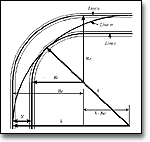
|
|
 |
PHYSICS OF RACING SERIES BRIAN BECKMAN NEWCASTLE, WASH. SOFTWARE ARCHITECT 1986 CHEVROLET CORVETTE, 1997 PLYMOUTH VOYAGER, 1998 MALLETT 435 CORVETTE, 1999 CHEVROLET TAHOE |
|
|
|
|
Better Lap Times Through Physics Reviewed June 14, 1999
In autocross, drivers zip one at a time around tight, twisting courses that reward precise car control and smoothness more than horsepower and a heavy throttle foot. "I was a terrible driver until I started figuring out what I was doing wrong by figuring out the physics," the 41-year-old Beckman recalls. "I got to be a competitive driver by doing the analysis and correcting the mistakes revealed by the analysis." When Beckman says "analysis," he's not kidding. He used 30 mathematical formulas alone to help calculate the fastest line through a 90-degree right-hand turn, for example. But after it was apparent that Newton's laws were helping him win autocross events in southern California, he shared his findings in 1991 with fellow members of the No Bucks Racing Club in the organization's newsletter.
Formulas for Success Much of Beckman's work is weighty stuff for those who think fast driving is all about white-knuckle, tire-screeching bravado. However, there is useful information that would-be Jeff Gordons and even people using computer-racing simulations will lap up. Think you know what your tires are trying to tell you? In "Keeping Your Tires Stuck to the Ground," Beckman notes: "Generally, tires 'squeak' when they are nearing the limit [of adhesion], 'squeal' at the limit and 'squall' over the limit."
Physics for the People Despite relying on physics to improve his driving, even Beckman concedes that "the driver's seat is not the place nor the time to think of such things." Instead, "feel and intuition" should lead you to the fast way around a track, helped, of course, "by strong technical knowledge." Beckman will continue to share his wisdom via an as-yet-unfinished 13th installment that is in the works. There are also several more articles "in various stages of completion," including one that uses a computer program to find the optimal path around a race course using Newton's laws. Stay tuned for more developments. Reported by Rick Popely for cars.com |
|
  MORE DETAIL
Beckman demonstrates his "back of the envelope" style of calculation.
INTRODUCTION TO THE RACING LINE
CYBERCAR Visit another autocrosser's personal site, which includes track video from behind the wheel.
MY FIRST AUTOCROSS EVENT
TOP TEN AUTO-CROSSING MUSTS |

